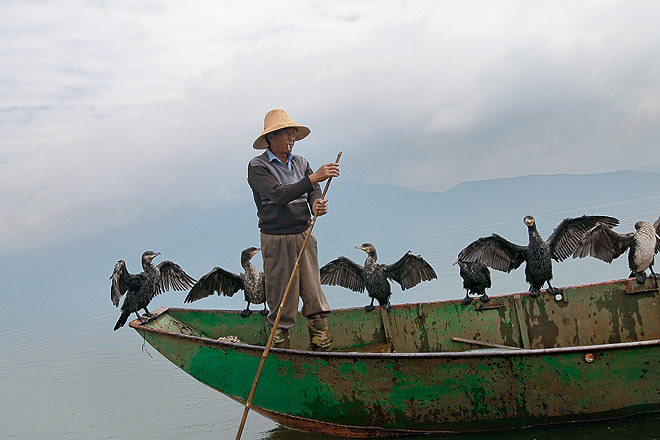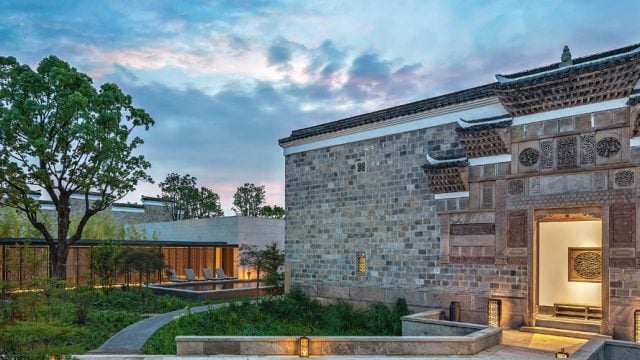A frisson of excitement wafted in with the cold air as I touched down in Kunming, the
Kunming teems with malls and skyscrapers, but it also boasts of a 2,000-year history, and is home to a mix of ethnicities, languages and cultures—and an emperor’s spread of culinary choices. The city was a vital link in the Old Tea Horse route, a network of caravan trails along which Yunnan traded in tea and salt with Bengal over the Nathu La, Tibet and the central provinces in China from about the 10th century CE. In modern times, Kunming saw action during the World War II as the headquarters of the Allied forces command; British forces moved supplies from Lashio to Kunming through the Burma Road. The famed Stilwell Road ran from Ledo in Assam to Kunming. The 1st American Volunteer Group, better known as the Flying Tigers, took off from Chabua in Assam and flew over ‘The Hump’ in the Himalaya carrying supplies, landing in Kunming in one of the most daring high-altitude operations in history, in an effort to stop the Japanese.
The city’s World War history is relived even today at the Hump Hostel in the heart of Kunming. On a wall inside the bar is a rare collection of pictures from the war. The hostel also has a commanding view of the Golden Horse and Jade Rooster Arch built during the Ming dynasty.
Both tradition and modernity sit lightly on Kunming. I walked around the cobbled main square, which is peppered with shopping malls, fancy bars, coffee bars, supermarkets, roadside shops and street food markets that sold everything from Yunnan tea to batik to my favourite flower pastry, jiahua, a delicate cookie filled with crushed rose petals, which melts in your mouth. That night, I feasted on the famed Rice Bridge Noodles, Yunnan’s signature dish, where the soup broth and ingredients are served separately.

Early the next morning, getting ready to leave for the stone forest in Shilin, some 125 km away, I met a rush of travellers from around the world at the hostel’s front desk. Shilin’s dramatic karst landscape, formed out of dissoluble rocks like limestone, dates back some 250 million years. Battery-operated shuttles ply inside the forest ferrying tourists; you can hop off at any of the locations en route, wind your way through some of the most bewitching formations, subterranean waterways and caves—or just stop and wonder at the beauty of nature. Which is just what I did before returning to Kunming.

My next stop was Dali, located five hours northwest of Kunming by bus. Few other places in China can rival Dali for its weather, idyllic setting, blue marble, blueberries, and nature’s bounty. The ancient capital of the Bai kingdom, Dali (altitude 2,000m) is sandwiched between the Erhai lake and Cang Shan mountain. It is home to the incredibly warm Bai inhabitants, who speak their own language. The city has fortified walls and impressive gates in all four directions, crowned by majestic arches.
Dali’s Old Town is best explored on foot, and on its cobbled streets, I found myself constantly surrounded by a bouquet of fragrances. Shops sold handicrafts, jewellery, batik, blueberries and flower pastries and fresh flowers. The next day, I hired a bicycle and breezed along the lake’s edge, passing through villages and stopping on the way to admire Dali’s raw beauty.
The Old Town of Lijiang is a replica of Dali, only a bit more touristy. The sky wore a scintillating blue over Lijiang as I arrived by bus from Dali. Home to the Naxi community, Lijiang is the crown jewel of northwest Yunnan. A Unesco World Heritage Site since 1999, the Old Town is a tightly woven jumble of lanes, cobbled streets, tiny brooks and wells leading up to a central square with a huge water wheel overlooking the Jade Dragon Snow Mountain. It’s easy to get lost here, and I promptly did.

Near the water wheel is a stall that sells bell charms. You write your wish on the charm and hang it in the forest of other bells. The belief is that if the bell falls off the charm, your wish will be granted. The centre of attraction is the old market square, which was once a haven for Naxi traders, who now sell everything from yak meat to tiger skin. It was here that the Mongol emperor Kublai Khan rested with his troops before he moved south to capture Dali. The Old Town, apart from being a compelling lure for foreign travellers, is also a haunt for the local girls who spend time in beauty salons before getting themselves photographed in traditional Naxi attire.
The Naxi belong to the ethnic Tibetan Qiang tribes and still maintain a matrilineal family system in which women run the show. Lijiang is replete with eateries, street food markets and restaurants that sell Naxi cuisine and Western dishes. I tried almost everything that I saw, including a local speciality called baba (wheat bread stuffed with vegetables and meat), the Naxi omelette and the Naxi sandwich (cheese, tomato, fried egg and meat sandwiched between two babas). My favourite was the mushroom hotpot and Naxi eggplant served in a boat-shaped crust filled with minced meat and rice followed by flower pastries and green tea mousse and freshly baked buns filled with red bean.
From Lijiang, I travelled on to Qiaotou, gateway to the famed Tiger Leaping Gorge, acclaimed by many a travel guide as the trek of a lifetime. One of the world’s deepest gorges, it is 16-kmlong. The maximum altitude on the high trail is close to 3,000m. The trek starts off relatively easy from Jane’s Guest House on the road before you veer left to catch the high trail. You can leave your extra luggage at Jane’s and pick it up on your way back from the trek. I caught up with other trekkers on the trail on my first stop at Nuoyo, where locals sold bottled water, coke, catapults, bamboo sticks, marijuana and smoking pipes. The real climb begins from here. After about 20-odd hairpin bends and an altitude gain of 600m, you arrive at Yacha village. From here, it’s a straightforward walk to Bendiwan, which is half-way into the trek.
The weather had almost turned when I checked into Come Inn, a new guest house that had a huge wooden deck facing the mountains, with the valley floor in between. This squeaky-clean place had a comfortable bed, hot showers, and a glass door that overlooked the deck and further into the mountains. Even at close to 3,000m, it had the luxury of free wi-fi! After breakfast the next day, I set off for the legendary Tiger Leaping Gorge.

The roaring Yangtze cuts through the gorge at about 1,800m. Legend has it that a tiger leapt across the gorge here to escape from its hunter. It could well have: this is the narrowest section of the gorge, although even here it is 15m wide. In the 1980s, a few daredevils tried rafting down, but were never seen again.
The descent gets steeper as you climb down for a ringside view and to the middle rapids. There are two viewpoints at the bottom where the locals charge 10 yuan, but one other is for free. A few shops dot the edge selling water, coke, jade and wild mushrooms. Chinese tourists were busy taking selfies and pictures, while the rest of us sat on the stone, stunned into silence. The water was muddy because of the rain, and silt and sand mining upstream. But the fury of the rapids near the Tiger Leaping Stone was mesmerising. And the roar—ah, the roar! It still rings in my ears, weeks later, an auditory cue that transports me to that ethereally enchanting spot.
The information
Getting there: China Eastern flies daily from Kolkata to Kunming; round-trip economy fares are about Rs 34,500. I flew from Guangzhou in southern China on my way in and flew back to Hong Kong, where I live. Dali is accessed by bus from Kunming (4-5 hours’ journey, buses every hour 7am–7pm, ¥105). Lijiang is connected by both train and bus from Kunming (8-10 hours by bus; ¥150-190). From Lijiang to Kunming is an overnight train journey (¥89 for seat; ¥150 for hard sleeper; ¥230 for soft sleeper; www.chinatrainguide.com).
Visa: China and India recently announced visa-on-arrival facility, but it’s not clear if it’s taken off yet. Visa applications can be submitted at the Chinese Embassy in Delhi, Mumbai, Chennai and Kolkata; see www.visaforchina.org for details. Single entry visa fees: Rs 3,900 plus service fee Rs 1,077.
Currency: 1 Yuan (¥) = `10.2
Where to stay:
KUNMING: Green Lake Hotel (doubles from ¥1,000) is centrally located, with great views, and offers first-rate service. Camellia Hotel (doubles from ¥400) has a mix of old and renovated rooms. Hump Hostel (doubles from ¥150), in the heart of Kunming, is a favourite during weekends. It has a bar, a rooftop restaurant, and English-speaking staff, and offers free wi-fi.
DALI: Jade Emu (doubles from ¥160), outside the West Gate of the Old Town, offers great service. Jim’s Tibetan Hotel (doubles from ¥300) is cosy and has a rooftop terrace, restaurant and bar. Dragonfly Guest House (doubles from ¥150) is popular with backpackers. The staff speak English, charge ¥10 to book your tickets, and help with bike rentals (¥20-40 for 8 hours).
LIJIANG: Blossom Hill (doubles from ¥450) is a boutique inn on a restored property. Garden Inn (doubles from ¥150), in the Old Town, is popular with backpackers. Oktober Inn (doubles from ¥150) is near the East Gate of the Old Town. Intercontinental Lijiang Ancient Town Resort (doubles from ¥1,300) offers over-the-top luxury.
ON THE TRAIL: Halfway Guest House (doubles ¥200), run by a Naxi family, is where most trekkers stay. The deck is windy and has spectacular views. Come Inn (doubles ¥150) is new on the trail, and offers commanding mountain views. Tina’s Guest House (doubles from ¥120) is right on the road.
What to do:
KUNMING: Lake Dian runs 40 km north to south, and areas around it are photogenic; the Xi Shan trail, on the western side of the lake, has temples tucked away inside a forest; Shilin Stone Forest has stunning karst formations (entry fee ¥175; and ¥25 for the forest shuttle).
DALI: Walk around the Old Town, or hire cycles, tandem bikes or electric scooters; Erhai Hu is China’s seventh-biggest freshwater lake, spread over 250 sq km, and the villages around it are best explored by bike; on the lake, you can watch the ingenious cormorant fishermen, who use the tethered birds to do the fishing for them; local markets convene every weekday at Shaping, 30km from Dali.
LIJIANG: Lijiang Old Town is great for a walkabout,although an entry fee of ¥80 is now being charged; Shue Old Town is quieter and somewhat more rustic than Lijiang; Yulong Xueshan (Jade Dragon Snow Mountain), 35km from Lijiang, is popular, particularly among Chinese tourists (entry fee: ¥105); Jade Peak Monastery (entry fee: ¥30) is at the foot of Jade Dragon Snow Mountain. To get to Tiger Leaping Gorge (entry fee: ¥65), take a bus from Lijiang to Qiaotou (3hrs; ¥40), and trek for a day to Bendiwan and another half-a-day to Walnut Garden.
Percy Fernandez
Yunnan province
Leave a Reply
You must be logged in to post a comment.





